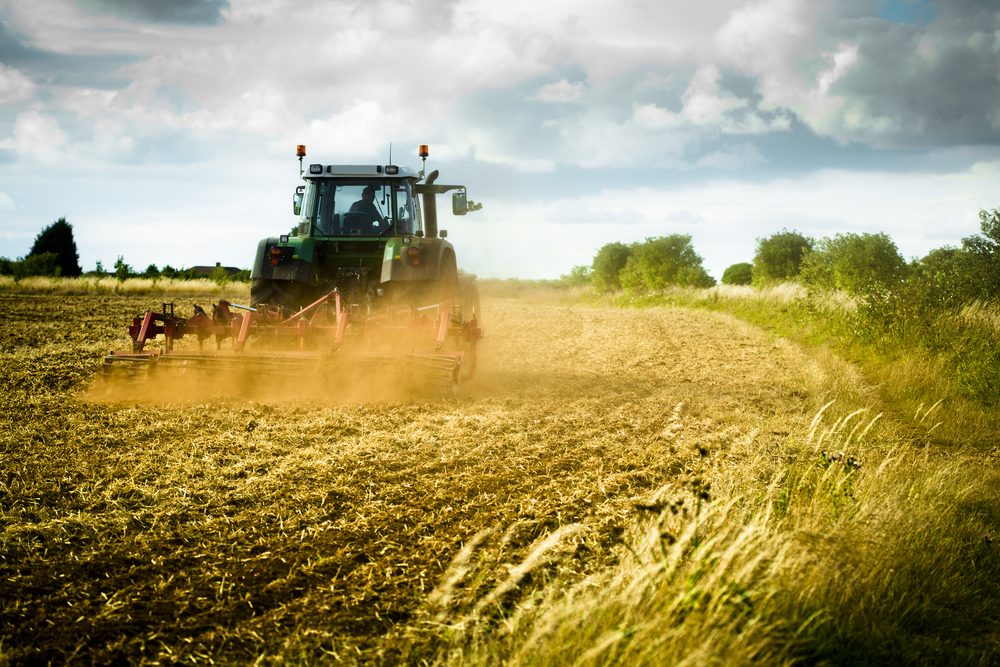Following the morale-boosting passage of U.S. tax reform, at least from a market perspective, President Trump turned his attentions to trade policy, in particular the U.S. current-account deficit vis-à-vis China and what he has deemed to be the theft of American intellectual property.
While trade policy has been on Trump’s agenda since the campaign trail, it has received renewed focus since the start of this year. With Canada, and in particular Mexico, having received the bulk of Trump’s attentions over the course of 2017, the prospect of a showdown between the world’s two largest economies has seemed at times to heighten market concerns.
Trump believes a trade war is easily won by the U.S., given its starting position as deficit country, but we believe the issue is far more complex. In order to explore the potential economic impact of increased barriers to trade, we think it’s useful to examine how the invention of the plough transformed modern society.
Step Back in Time
Some 12,000 years ago, humans were almost entirely nomadic, relying on hunting and gathering to find sufficient food to survive. It was a time when the world was emerging from a prolonged cold snap; animals were migrating to the river valleys in search of water, and people followed. These fertile but geographically limited river valleys changed the way food was sourced and it became increasingly rewarding to encourage the flora and fauna as opposed to roaming around foraging.
Humans began the practice of breaking the surface of the soil in order to allow nutrients to the surface and water to seep deeper. Initially, this was done by hand with the use of sharp sticks, but over time, a simple scratching plough, pulled by a pair of beasts, was adopted and the practice of agriculture took off. By the time of the Roman Empire, farming was well established, with farmers five or six times more productive than the foragers they had replaced; thus it was possible for a fifth of a society’s population to grow enough food to feed everyone.[1]
This advancement freed up the remaining 80% to carry out other productive work, which in turn gave rise to specialist producers such as bakers, builders and brewers, thus enabling an increase in total production. Ploughs made their debut in the Middle East, where simple scratch ploughs were suited to the dry gravelly soils, and in time spread across the Mediterranean.
The Moldboard Plough
The fertile wet clays of northern Europe required a more heavy-duty piece of kit, however. Settlers on the plains of northern Europe engineered the moldboard plough which cut a long, thick ribbon of soil and turned it upside down, improving drainage and killing deep-rooted weeds, turning them from competition into compost. The development of the moldboard plough had profound implications for the course of history: northern Europe had always had fertile land, but the heavy, dense nature of the clay meant that it was incredibly difficult to farm versus the drier, less nutrient-rich soils of the Mediterranean. The advent of the moldboard plough meant it was the northern Europeans, rather than the Mediterranean natives, who enjoyed the best and most productive land. Consequently, starting around a thousand years ago, cities in northern Europe emerged and started to flourish.
The Accumulation of Capital
As with any piece of equipment that makes up the capital stock, ploughs do not conveniently come into existence of their own accord. The process of capital accumulation requires that we forego the consumption of some amount of what is produced in order to invest in the capital stock. Additionally, just as the construction of a plough requires labor and resources, procuring and sustaining the oxen and horses needed to provide the power to cut through the heavy clays of northern Europe also required investment in the form of time and resources.
Why Accumulate Capital?
The incentive to commit time and resources to the production of capital goods is done in the hope that it will realize future increases in output per unit of labor. In other words, time that would otherwise have been spent producing output for consumption or indulging in leisure activities is committed to the manufacture of tools that will facilitate production down the line, or, in other words, investing now to improve future returns. In the case of the plough, the rewards came in the form of significantly increased yields and food surpluses which supported larger populations and increased labor specialization. This, in turn, led to bigger economies and, importantly, an increase in output per person. It is this increased output per unit of labor that drives gains in productivity and underpins increases in living standards.
Stranded Capital
So what does any of this have to do with the rising risk of trade wars?
Despite Trump’s suggestion to the contrary, we would argue that trade wars tend not to be won by anyone. Of course, the exporting country loses from a trade war, but so too does the importing one.
The reason why there are no winners is because it is normally a scenario that leads to the substitution of more expensive goods for cheaper ones. As barriers to trade and financial capital have fallen over past decades, huge amounts of resources have been invested in building out the capital needed to operate global supply chains. Profit might be the main motivation, but the parallel outcomes have been huge productivity gains (a significant proportion of which will have led to increased standards of living through lower prices and product choice) and new jobs created, as with the invention of the plough a thousand years ago.
A trade war threatens to destroy the productivity gains that have been realized through the expansion of global supply chains, and could effectively deprive U.S. and global consumers of the cheaper goods that come with it. Protectionism would be likely to lead to an increase in prices, while also being demand-destructive.
One only has to go back as far as 2002, the last time steel tariffs were enacted, to see the potential economic costs. Following a spate of mill closures and surging imports, President Bush implemented tariffs on certain steel products. While the net effect on employment in the steel industry was minimal, the businesses that relied on steel products shed approximately 200,000 jobs – more than the 180,000 employed in U.S. steel production at the time.[2]
As a result of the tariffs, U.S. manufacturing firms, in particular smaller companies, were subjected to higher input prices which eroded profitability. Unable to increase prices, once-profitable companies were forced to cut production and, with it, their labor force.
Thus, while the intention of tariffs and trade barriers is to repatriate jobs which are seen to have been lost overseas, the outcome is often higher prices and job losses at home.
The Unstoppable March of Technology
When the U.S. imposed steel tariffs in 2002, it produced almost as much steel as it does today. However, today there remains only a fraction of the 2002 workforce, as advancements in technology – in the form of both physical and intellectual capital – have boosted productivity just as the plough did one millennium ago.
More broadly, U.S. manufacturing has progressively increased production for decades, even as the sector has shrunk in terms of both the number of people employed and as a proportion of GDP.
While these productivity gains have delivered increased welfare at the aggregate level, the process of substituting labor for capital has costs, particularly for those members of the workforce who are displaced. Today the U.S., along with all developed countries, produces more food with less than 2% of its workforce, compared to the days when 50% of its workforce were farmers. Since the introduction of the plough, continued productivity gains have reduced the need for agricultural labor but, over time, that displaced labor has been reallocated to other productive work, to the benefit of society’s welfare.
While this process is societally disruptive in the short term, over the long term it reaps huge rewards. To have tried to halt that process in the past by smashing up ploughs, or any other agricultural or industrial machinery for that matter as some have tried to do, would have ultimately hurt the consumer and restricted jobs, just as we would argue trade wars threaten to do today.
[1] http://timharford.com/books/50things/
[2] http://www.tradepartnership.com/pdf_files/2002jobstudy.pdf
This is a financial promotion. Material in this publication is for general information only. The opinions expressed in this document are those of Newton and should not be construed as investment advice or recommendations for any purchase or sale of any specific security or commodity. Certain information contained herein is based on outside sources believed to be reliable, but its accuracy is not guaranteed. You should consult your advisor to determine whether any particular investment strategy is appropriate. This material is for institutional investors only. Any reference to a specific security, country or sector should not be construed as a recommendation to buy or sell this security, country or sector. Please note that strategy holdings and positioning are subject to change without notice.
Important information
This is a financial promotion. Issued by Newton Investment Management Limited, The Bank of New York Mellon Centre, 160 Queen Victoria Street, London, EC4V 4LA. Newton Investment Management Limited is authorized and regulated by the Financial Conduct Authority, 12 Endeavour Square, London, E20 1JN and is a subsidiary of The Bank of New York Mellon Corporation. 'Newton' and/or 'Newton Investment Management' brand refers to Newton Investment Management Limited. Newton is registered in England No. 01371973. VAT registration number GB: 577 7181 95. Newton is registered with the SEC as an investment adviser under the Investment Advisers Act of 1940. Newton's investment business is described in Form ADV, Part 1 and 2, which can be obtained from the SEC.gov website or obtained upon request. Material in this publication is for general information only. The opinions expressed in this document are those of Newton and should not be construed as investment advice or recommendations for any purchase or sale of any specific security or commodity. Certain information contained herein is based on outside sources believed to be reliable, but its accuracy is not guaranteed. You should consult your advisor to determine whether any particular investment strategy is appropriate. This material is for institutional investors only.
Personnel of certain of our BNY Mellon affiliates may act as: (i) registered representatives of BNY Mellon Securities Corporation (in its capacity as a registered broker-dealer) to offer securities, (ii) officers of the Bank of New York Mellon (a New York chartered bank) to offer bank-maintained collective investment funds, and (iii) Associated Persons of BNY Mellon Securities Corporation (in its capacity as a registered investment adviser) to offer separately managed accounts managed by BNY Mellon Investment Management firms, including Newton and (iv) representatives of Newton Americas, a Division of BNY Mellon Securities Corporation, U.S. Distributor of Newton Investment Management Limited.
Unless you are notified to the contrary, the products and services mentioned are not insured by the FDIC (or by any governmental entity) and are not guaranteed by or obligations of The Bank of New York or any of its affiliates. The Bank of New York assumes no responsibility for the accuracy or completeness of the above data and disclaims all expressed or implied warranties in connection therewith. © 2020 The Bank of New York Company, Inc. All rights reserved.
In Canada, Newton Investment Management Limited is availing itself of the International Adviser Exemption (IAE) in the following Provinces: Alberta, British Columbia, Ontario and Quebec and the foreign commodity trading advisor exemption in Ontario. The IAE is in compliance with National Instrument 31-103, Registration Requirements, Exemptions and Ongoing Registrant Obligations.





